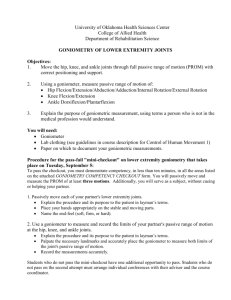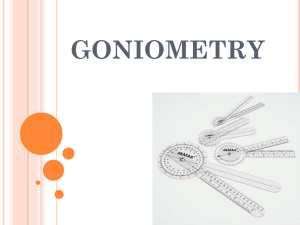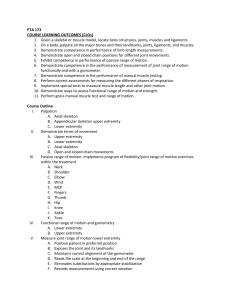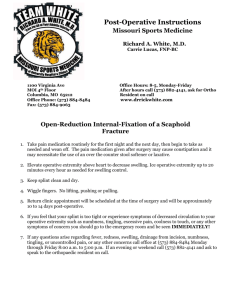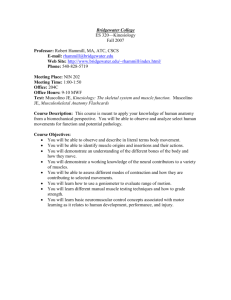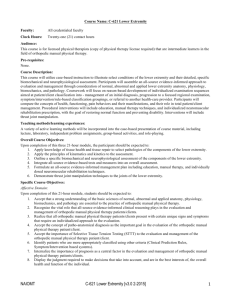RELIABILITY OF A KINEMATIC MODEL OF THE UPPER
advertisement
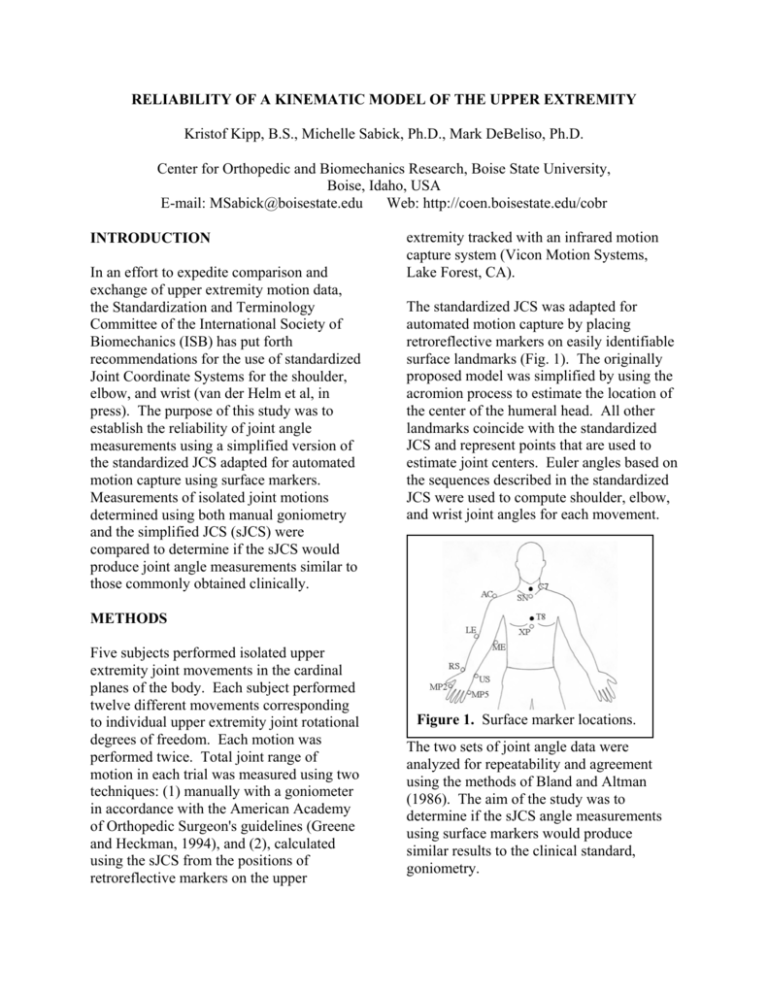
RELIABILITY OF A KINEMATIC MODEL OF THE UPPER EXTREMITY Kristof Kipp, B.S., Michelle Sabick, Ph.D., Mark DeBeliso, Ph.D. Center for Orthopedic and Biomechanics Research, Boise State University, Boise, Idaho, USA E-mail: MSabick@boisestate.edu Web: http://coen.boisestate.edu/cobr INTRODUCTION In an effort to expedite comparison and exchange of upper extremity motion data, the Standardization and Terminology Committee of the International Society of Biomechanics (ISB) has put forth recommendations for the use of standardized Joint Coordinate Systems for the shoulder, elbow, and wrist (van der Helm et al, in press). The purpose of this study was to establish the reliability of joint angle measurements using a simplified version of the standardized JCS adapted for automated motion capture using surface markers. Measurements of isolated joint motions determined using both manual goniometry and the simplified JCS (sJCS) were compared to determine if the sJCS would produce joint angle measurements similar to those commonly obtained clinically. extremity tracked with an infrared motion capture system (Vicon Motion Systems, Lake Forest, CA). The standardized JCS was adapted for automated motion capture by placing retroreflective markers on easily identifiable surface landmarks (Fig. 1). The originally proposed model was simplified by using the acromion process to estimate the location of the center of the humeral head. All other landmarks coincide with the standardized JCS and represent points that are used to estimate joint centers. Euler angles based on the sequences described in the standardized JCS were used to compute shoulder, elbow, and wrist joint angles for each movement. METHODS Five subjects performed isolated upper extremity joint movements in the cardinal planes of the body. Each subject performed twelve different movements corresponding to individual upper extremity joint rotational degrees of freedom. Each motion was performed twice. Total joint range of motion in each trial was measured using two techniques: (1) manually with a goniometer in accordance with the American Academy of Orthopedic Surgeon's guidelines (Greene and Heckman, 1994), and (2), calculated using the sJCS from the positions of retroreflective markers on the upper Figure 1. Surface marker locations. The two sets of joint angle data were analyzed for repeatability and agreement using the methods of Bland and Altman (1986). The aim of the study was to determine if the sJCS angle measurements using surface markers would produce similar results to the clinical standard, goniometry. RESULTS AND DISCUSSION Goniometry: The intra-observer interclass reliability coefficient for all joints was r≥0.99. The mean and standard deviation (SD) of the intra-observer differences for all joints were -0.23± 3.3°. 93% of the intraobserver differences were within ± 2 SD of the mean difference. sJCS: The interclass reliability coefficient for all joints was r≥0.99. The mean and SD of the differences for all joints was -1.8± 3.4°. 94% of the differences were within ± 2 SD of the mean difference. Goniometry vs. sJCS: The interclass reliability coefficient between the two measurement techniques was r=0.95 (Fig. 2). The mean and SD of the technique differences for all joints was 13.6± 12.1°. 98% of the technique differences were within ± 2 SD of the mean difference. These results show a high agreement between the two joint measurement techniques and suggest that the sJCS is suitable for the measurement of human upper extremity motion. Goniometer Angle (deg) 180 The goniometer generally produced greater range of motion values than did the sJCS method. The one exception was internal rotation of the humerus, where the sJCS measurements were greater. The maximum difference between techniques was 38° for shoulder abduction and the minimum difference was 1° for ulnar deviation. Even though the acromion process was used to estimate the glenohumeral joint center, the shoulder angle measurements calculated using the sJCS were still significantly related to the goniometer measurements. For many applications, this simplification may be sufficiently accurate. Refining the methods for locating the shoulder joint center is a focus of our ongoing research. SUMMARY The simplified ISB Joint Coordinate System shows promise for use in upper extremity motion capture using surface markers. The landmarks used are prominent, easy to identify, and yield highly repeatable measures. A better method for identifying the shoulder joint center is still needed as the calculations using the acromion process to approximate the humeral head produced the greatest measurement variability. 160 REFERENCES 140 120 100 r=0.95 80 60 40 20 0 0 20 40 60 80 van der Helm, F.T.C. et al. (in press). J. Biomechanics Greene, W.B., Heckman, J.D. (1994). The clinical measurement of joint motion. Amer. Acad. of Orthopaedic Surgeons. Bland, J. M., Altman, D. G. (1986). Lancet, 1, 307-310. 100 120 140 160 180 sJCS Angle (deg) Figure 2. Correlation between goniometer and sJCS measurements of joint angle for all 13 upper extremity motions. ACKNOWLEDGEMENTS The authors would like to thank Kristin Bovey for her invaluable support.
